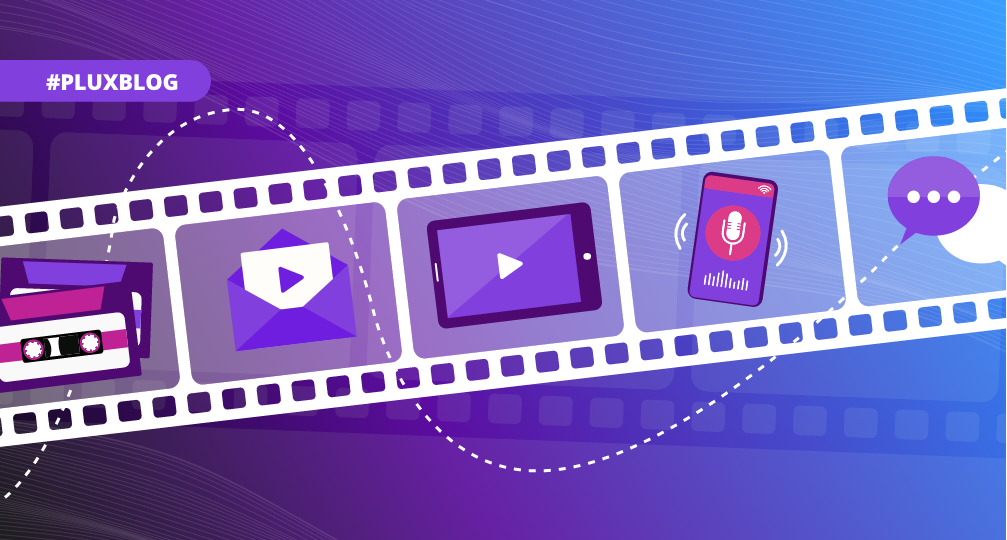Read a full research on the topic in our white paper.
Consumers tremendously changed their expectations from content providers. With all the abundance of entertainment content across various channels, the competition over consumers' attention has become more intense. Having great content is no longer enough. Companies have to assure that they provide high-quality user experiences, customised and versatile content, relevant recommendations and instant availability (World Economic Forum, n.d.). Personalisation has become the key to higher engagement rates. For example, more than 80% of the media content people watch on Netflix are discovered through recommendations (Nesbitt, 2021). However, to deliver personalisation it is crucial to invest in proper technologies, which will allow to collect real-time insights about consumer behaviour and create more complex multi-channel experiences.
Following consumers's rising appetite and digital advancements, media companies have to meet new demands across multiple platforms. Otherwise, they risk missing important touch points in a customer journey. This trend is especially relevant for traditional media companies, which built their decades-long success on mainstream technologies of the past century. Even if a company comes up with highly relevant and binge-worthy content, it will most likely remain undiscovered, because of the outdated content distribution strategy. For example, Disney could not avoid making this mistake. American Crime Story is a very well-known limited-series filled with A-list stars. The first two seasons won Emmys for best limited series. However, the third season did not get an anticipated demand, because it was solely broadcasted on the FX television channel while its target audience was dominantly consuming content from streaming services like Netflix and Hulu (Simon, 2022). Traditional TV is simply getting less relevant for younger audiences: 45% of users, who are younger than 30, agree with this statement. On top of that, more than half state that streaming services have replaced traditional TV for them (Simon-Kucher & Partners, 2022). This trend shows another evidence that a consumer relies on the digital environment as their primary source of media consumption.
Sooner or later many media companies adjust their strategies and expand their reach to a digital environment. But even being present online or offering the abundance of content is not enough to retain picky young customers. More than half of online streaming services' users cancel or both add and cancel their subscription plans within six months. The main reason behind it is a continuous chase after desired content across different channels (Deloitte, 2022). It proves that it is still challenging even for the most advanced companies to fully satisfy their customers. Therefore, it is even twice as important to support your creative teams with proper technological solutions to enable data-driven content creation.
The fundamental shift in consumer behaviour was also reflected in the global advertising spending. Digital ads investments accounted for nearly 62% of the total. The second biggest share is television, but it is only 23% (Statista, 2022).
On the other hand, a consumer is not the only party a media company has to keep up with. Success of any type of content is also heavily dependent on satisfaction of creative teams. It is not a secret that a global pandemic has forcefully disrupted a standard working routine. This event caused organisations to adapt to remote working for their teams. However, even the post-pandemic world was not willing to come back to offices. According to the research conducted by Microsoft, 85% of business leaders do not have confidence in the productivity of their employees when they work remotely. Moreover, half of the companies want their workers back at the office (Microsoft, 2022). At the same time, employees report that they are more productive with hybrid or remote arrangements than at the office. (PwC, 2021). Based on this positive trend, employees would not want to come back to the office full-time. Otherwise, organisations risk to lose 39% of their workforce (Gartner, 2022). Your creative teams are a direct link between your company and a target audience. Therefore, their satisfaction is directly related to the satisfaction of your audience. To assure the happiness of creative teams, business leaders have to be ready to provide a digital working environment that assists in productive and synchronised work of all the people.
In present market settings, it has become even more challenging to stay afloat: meeting complex and fluid market demands, keeping an eye on a newly developed competition and making sure your company does not lag behind in the digital transformation journey. The last one has an utmost importance as it gives a necessary edge to tackle other challenges.
Do you want to know if your company is on the right track of its digital course? Stay tuned for our next blog or get the answers right now in our White paper.
Reference List
Deloitte. (2022, March 28). 2022 Digital media trends, 16th edition: Toward the metaverse. Retrieved form https://www2.deloitte.com/us/en/insights/industry/technology/digital-media-trends-consumption-habits-survey/summary.html
Gartner. (2022, June 16). 9 Future of Work Trends Post Covid-19. Retrieved from https://www.gartner.com/smarterwithgartner/9-future-of-work-trends-post-covid-19
Microsoft. (2022, March 16). Great Expectations: Making Hybrid Work. Retrieved from https://www.microsoft.com/en-us/worklab/work-trend-index/great-expectations-making-hybrid-work-work
Nesbitt, T. (2021, September 17). 3 Ways Media and Entertainment Companies Can Leverage Behavioral Data. Retrieved from https://amplitude.com/blog/media-entertainment-personalization
PwC. (2021, January 2021). It’s time to reimagine where and how work will get done. Retrieved from https://www.pwc.com/us/en/services/consulting/business-transformation/library/covid-19-us-remote-work-survey.html
Simon, A. (2022, March 16b). The Shift from Windowing to Omnichannel Distribution is Reshaping the Entertainment Industry. Retrieved from https://medium.com/@adamjsimon/the-shift-from-windowing-to-omnichannel-distribution-is-reshaping-the-entertainment-industry-394d5f509254
Simon-Kucher & Partners. (2022, August 24). Global Streaming Trends 2022: Subscription Fatigue on the Rise. Retrieved from https://www.simon-kucher.com/en/blog/global-streaming-trends-2022-subscription-fatigue-rise
Statista. (2022). Distribution of advertising spending worldwide in 2022, by medium. Retrieved from https://www.statista.com/statistics/376260/global-ad-spend-distribution-by-medium/
World Economic Forum. (2016, January 22). Digital Transformation of Industries. Retrieved from https://reports.weforum.org/digital-transformation/the-media-industry-in-the-vanguard-of-digital-transformation/

